Absolute Towers by MAD
Chinese firm MAD has completed a pair of curvaceous twisted skyscrapers in the growing city of Mississauga, Canada (+ slideshow).
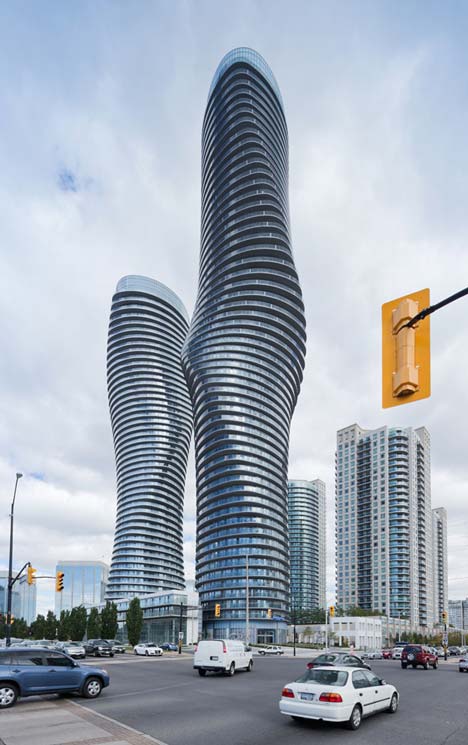
Standing at 170 and 150 metres, the Absolute Towers contain apartments on each of their oval-shaped floors, but every storey is incrementally rotated to give both buildings a curved and twisted outline.
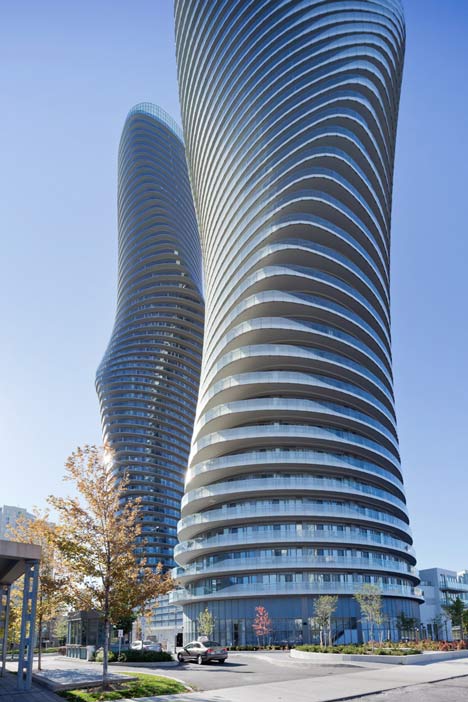
"The concept of the tower at the beginning was very simple," said MAD founder Ma Yansong. "We just wanted to make something organic but different, more natural and more soft and not something too strong that would remind people of money or power."
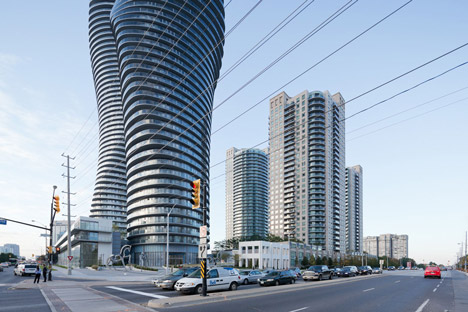
Mississauga first developed as a suburb of Toronto but has grown in recent decades and was named as a city in 1974. Since then, high-rise developments have sprung up across the city and the architects were keen to avoid designing another of these "listless, boxy buildings".
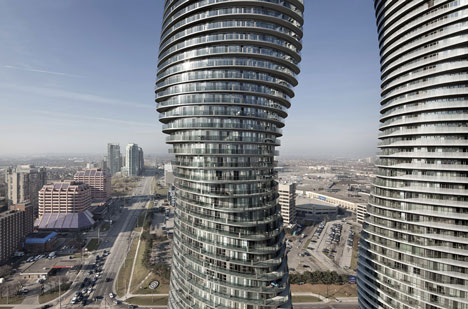
"Lots of cities like this are happening in China, just repeating the modern urban typology and always making square towers," added Yansong. "We were thinking; how about reversing that? "So we don't treat architecture as a product, or an artificial volume or space. It's more like a landscape."
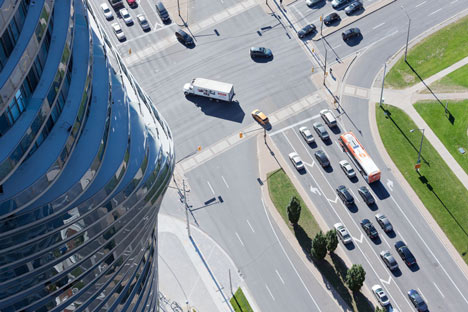
MAD won a competition to design the buildings in 2006, which were initially dubbed "the Marylyn Monroe towers" by local residents in reference to their shapely bodies.
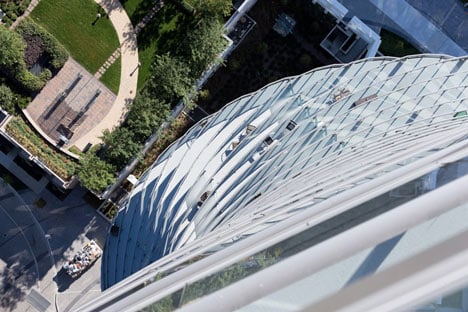
Apartments in both towers boast panoramic views of the city skyline from continuous balconies that wrap around the recessed glass facades. This set-back also helps to shade each apartment from direct sunlight in the summer months.
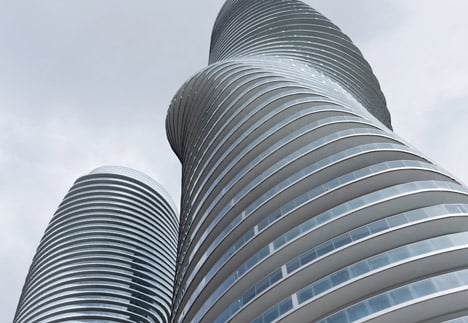
MAD also recently unveiled plans for a village of towering apartment blocks beside the Huangshan Mountains in China.
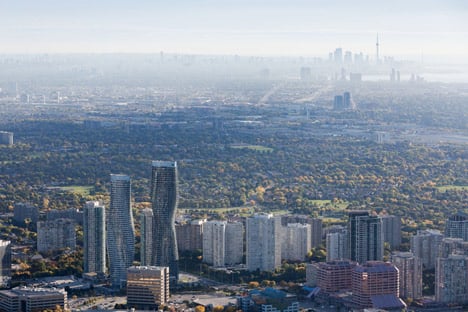
See more architecture by MAD, including a museum the firm completed last year in the desert city Ordos.
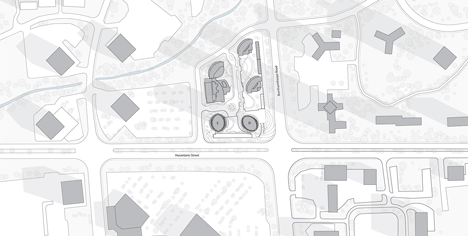
Above: site plan - click above for larger image
Photography is by Iwan Baan.
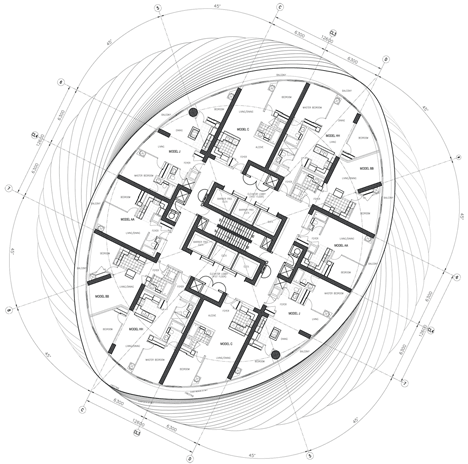
Above: typical floor plan - click above for larger image
Here's a project description from MAD:
Absolute towers
We call our cities steel concrete forests.
Throughout the process of urbanization, skyscrapers have been symbols of technological bravado, prime capitals and the societal projections of wealth and prosperity. This limited framework for skyscrapers often results in solutions limited by homogenous, linear structures and degenerative duplication in business districts across the globe. Forced into an unnatural state of conformity, metropolitan life is negatively affected by these unchecked, efficiency-centric development practices. Without a challenge to the status quo, our cities will continue to lack the cohesion of life as implied by the term: forest. A forest is a thriving ecosystem wherein every organism survives only in a state of symbiosis. New ambitions nurtured in a changing global consciousness challenge the aging pattern of last century's development and favor fresh thoughtful, inspiring and eloquent solutions for tomorrow's high-rises.
What lies in the future of our cities? How should one grasp the concept of emerging high-density cities? How can city dwellers be immersed with an enriching experience of nature when its presence steadily diminishes in the face of the ever intensifying concrete inundation? Faced with these challenges, future high-rise buildings need to catalyze a higher level of complexity in our cities for the sake of harmonious civilization.
Fondly dubbed the Marylyn Monroe towers by local residents, the Absolute Towers parallel the twisting fluidity or natural lines found in life. This activation of flow forms an organic punctuation in the landscape and a desire for an urban acknowledgement of enthusiasm. Here, we thrive to challenge the sustenance of commonplace boxy skyscrapers. Our ambition was to provide each resident a unique experience of the city, a heterarchitical distribution. Continuous balconies widen individual viewing angles and promote community at the micro scale of a single floor. At the macro, the cadence of the floors rising into the sky echo the modular rhythms of the human experience, yet emphasizes the movement of an adoring figure. We hope this building can wake up metropolitans’ desires towards nature, such as sun and wind, and certainly, human bodies.
A Crisis of Identity
Like other suburbs in North America, Mississauga, near Toronto, has been quickly developing into an independent, urbanized area. Yet, the cityscape lacked a unique character. In response, we wanted to add something naturalistic, delicate and human in contrast to the backdrop of listless, boxy buildings. Sited at the junction of two main streets (Hurantario and Burnhamthorpe), the Absolute Towers gracefully bear their landmark status and act as a gateway to the city beyond. As a residential landmark that strives for more than simple efficiency, the buildings provide residents an emotional connection to their hometown and neighbors.
Eschewing the tradition of accentuated verticality in high-rises, the Absolute Towers choose not to emphasize vertical lines. Instead, the design features a smooth, unbroken balcony that wraps each floor of the building. In addition, at each successive level, the floor plate rotates in a range of one to eight degrees affording breathtaking panoramas of the Mississauga skyline concluding in reverence to the principle street intersection at its peak. By maximizing the viewing potentials inside and out, creating a wonderful medium for social interaction throughout the balconies, and connecting the city dwellers with naturalistic design principles, Mississauga is infused with a new character.
A New Sustainability
In place of the basic, functional logic of an aging modernism, the current trend of sustainable design is reminiscent of the sudden rise in the glass-faced boxy buildings of last century. Sustainability, in concept, is often unfortunately simplified to the lowest common denominator. If we limit the scope of sustainable ecology to energy savings, it will become merely a demand for comfort while the yearning of a return to nature is ignored. This design practice remains the axiom of the industrial revolution, man controls nature. We feel sustainability is a much greater concept which can guide a new culture of design resulting in real change. For instance, in traditional Chinese gardens, building and nature elements are integrated to create a spiritual and poetic environment fostering great literature, poem and music, or simply life and philosophy. Our approach, ergo, is to create a balanced environment that evokes the feeling of exploring nature while simultaneously a responsive model for the development of urban space in harmony with nature. A sustainable architecture in modern concept. Real sustainability results in a harmonious civilization.
This is the biggest challenge of our time. How do we rebuild urban environments with life and emotion where people are connected and respected?
An Economy of Structure
The torsional form of the towers is underpinned with a surprisingly simply and inexpensive structural solution. The two residential towers are supported by a grid of concrete load bearing walls. The bearing walls extend and contract in response to the sectional fluctuation created by the rotation of the floors while the balconies consist of cantilevered concrete slabs. In order to ensure the elegant edge profiles are as thin as possible, there is a thermal break in the slabs at the exterior glazing such that the insulation need not wrap the entirety of the balconies. Meanwhile, the dynamically fluid shaping of the towers, naturally aerodynamic, adeptly handles wind loading and ensures comfort throughout all the balconies. Besides providing every resident with a nice exterior place to enjoy views of Mississauga, the balconies naturally shade the interior from the summer sun while soaking in the winter sun, reducing air conditioning costs.
Location: Mississauga, Canada
Height: 170 meter
No. of floors: Tower A: 56 stories/170 m
Tower B: 50 stories/150 m
Building Area: 95.000 square meters
Tower A: 45,000 sqm
Tower B: 40.000 sqm
Site area: 4090 square meters
Primary Use: Residential
Client: Fernbrook / Cityzen
Design Architect: MAD architects
Director in Charge: Ma Yansong, Yosuke Hayano, Dang Qun
Design Team: Shen Jun, Robert Groessinger, Florian Pucher, Yi Wenzhen, Hao Yi, Yao Mengyao, Zhao Fan, Liu Yuan, Zhao Wei, Li Kunjuan, Yu Kui, Max Lonnqvist, Eric Spencer
Associate Architects: BURKA Architects INC.
Structural Engineer: SIGMUND, SOUDACK & ASSOCIATES INC.
Mechanical Engineer: ECE Group
Electrical Engineer: ECE Group
Landscape Architect: NAK Design
Interior Designer: ESQAPE Design